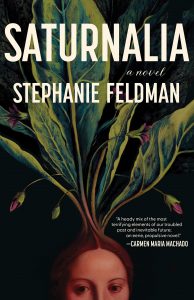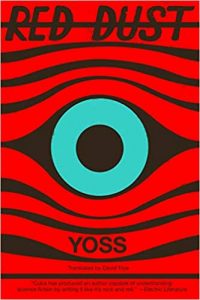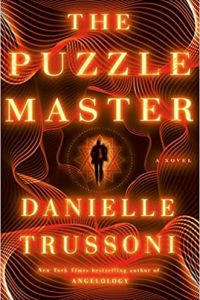Gary K. Wolfe Reviews Saturnalia by Stephanie Feldman
 Saturnalia, Stephanie Feldman (Unnamed Press 978-1951213640, $28.00, 256pp, hc) October 2022.
Saturnalia, Stephanie Feldman (Unnamed Press 978-1951213640, $28.00, 256pp, hc) October 2022.
It’s been a few years since Stephanie Feldman received the Crawford Award for her first novel, The Angel of Losses, a notable addition to the list of contemporary fantasies that draw on elements of both Jewish mysticism and Gothic tradition, so it’s a delight to find that she’s back, and with a very different sort of novel – although the Gothic elements are still firmly in place. Saturnalia belongs to that intriguing tradition of tales that unfold over a single phantasmagoric night – at times it feels as though Fellini decided to remake La Dolce Vita after reading a chunk of Tim Powers – and for a fairly short novel, it has some significant cross-genre lifting to do. Set in a near-future alternate Philadelphia in which a midwinter Saturnalia has become an annual debauch, and in which various powerful social clubs celebrate and draw power from a variety of ancient gods – Baldur, Mithras, Quetzalcoatl, Ishtar, Osiris, Pan, etc. – it details the overnight adventures of Nina, a young woman who three years earlier had given up a promising role in the Saturn Club following a traumatic event whose details we only gradually learn. Now she is asked by her old friend and clubmate Max to infiltrate the club’s Saturnalia bash in order to steal a mysterious box hidden somewhere in the club mansion. Needless to say, things don’t go quite as planned.
Saturnalia quickly unfolds as a suspenseful supernatural tale, eventually involving ancient alchemy, a scrying mirror, a homunculus, an ominous masked stranger who seems to be stalking Nina, and a fearsome monster called a Mandragora. But this is only one of four narrative lines which Feldman balances with balletic efficiency. We also learn that climate change has radically damaged the world, not only with extreme weather events such as floods and tornadoes, but with a growing colony of homeless climate refugees, giving the novel a substantial fillip of apocalyptic SF. Yet a third narrative line involves Philadelphia itself. Nina’s adventures during the city’s hallucinatory Saturnalia celebrations take her from upscale wealthy neighborhoods through Wanamaker’s department store, the museum of art (where a favorite Henri Rousseau painting of Nina’s gives a clue to the visual atmosphere of the novel), the university district, Fairmount Park, and the old Laurel Hill Cemetery. I know almost nothing about the geography of Philadelphia, but got the sense that I could nearly find my way around based on the acute sense of place of Nina’s nighttime odyssey.
The most rewarding narrative line, though, depends entirely on character – not only Nina herself, but on the complex history of friendships, betrayals, and loyalties involving her ex-lover and mentor East, the former colleague Max who enlists her in an unexpectedly hazardous assignment, her best friend Amparo, another friend named Ronan who has transitioned to become Rhea, and a cast of sharply sketched minor characters. As much as we might find her overnight odyssey fraught with danger – there are some generally scary moments and one disturbing bloodbath – we’re equally intrigued by Nina’s backstory and her possible future. What really caused her to abruptly abandon her promising career at the Saturn Club? Is this particular Saturnalia, as one character insists, really a sign of the end times? As I and others have often noted before, the lines between the various subsets of fantastika (see Clute and Attebery below) seem increasingly porous these days, and Saturnalia draws freely on traditions of horror, apocalyptic fiction, and alchemical fantasy in a way that makes us suspect those lines were never really there in the first place.
Gary K. Wolfe is Emeritus Professor of Humanities at Roosevelt University and a reviewer for Locus magazine since 1991. His reviews have been collected in Soundings (BSFA Award 2006; Hugo nominee), Bearings (Hugo nominee 2011), and Sightings (2011), and his Evaporating Genres: Essays on Fantastic Literature (Wesleyan) received the Locus Award in 2012. Earlier books include The Known and the Unknown: The Iconography of Science Fiction (Eaton Award, 1981), Harlan Ellison: The Edge of Forever (with Ellen Weil, 2002), and David Lindsay (1982). For the Library of America, he edited American Science Fiction: Nine Classic Novels of the 1950s in 2012, with a similar set for the 1960s forthcoming. He has received the Pilgrim Award from the Science Fiction Research Association, the Distinguished Scholarship Award from the International Association for the Fantastic in the Arts, and a Special World Fantasy Award for criticism. His 24-lecture series How Great Science Fiction Works appeared from The Great Courses in 2016. He has received six Hugo nominations, two for his reviews collections and four for The Coode Street Podcast, which he has co-hosted with Jonathan Strahan for more than 300 episodes. He lives in Chicago.
This review and more like it in the Sepetmber 2022 issue of Locus.
 While you are here, please take a moment to support Locus with a one-time or recurring donation. We rely on reader donations to keep the magazine and site going, and would like to keep the site paywall free, but WE NEED YOUR FINANCIAL SUPPORT to continue quality coverage of the science fiction and fantasy field.
While you are here, please take a moment to support Locus with a one-time or recurring donation. We rely on reader donations to keep the magazine and site going, and would like to keep the site paywall free, but WE NEED YOUR FINANCIAL SUPPORT to continue quality coverage of the science fiction and fantasy field.
©Locus Magazine. Copyrighted material may not be republished without permission of LSFF.








